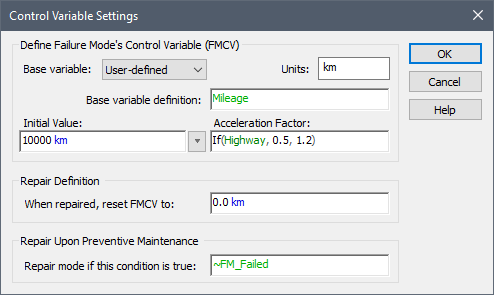 Warning: If your user-defined
base variable does not increase (or remain unchanged) with time, GoldSim will
display a fatal error message.
Warning: If your user-defined
base variable does not increase (or remain unchanged) with time, GoldSim will
display a fatal error message.
In some cases, it may be appropriate to define an FMCV which is defined with respect to a base variable other than time or the number of actions completed (e.g., mileage). Any monotonically increasing function can be specified as a base variable. In most cases, a user-defined base variable will be an Integrator, Reservoir or Pool element.
 Warning: If your user-defined
base variable does not increase (or remain unchanged) with time, GoldSim will
display a fatal error message.
Warning: If your user-defined
base variable does not increase (or remain unchanged) with time, GoldSim will
display a fatal error message.
For example, if you were modeling the reliability of a car, you might want to use the car’s mileage (i.e., distance traveled) the base variable. An Integrator element could be used to track the car’s mileage through its life.
To make mileage a user defined FMCV, you would select User defined from the drop down list, specify miles as the Units, and simply create a link to the Mileage integrator in the Base variable definition field:

This failure mode’s input parameters (e.g., mean and SD if it was a Normal failure mode) can now be defined in terms of distance (e.g., miles).
 Note: In the example shown
above, an Initial Value and an Acceleration Factor have been defined.
These convert the base variable (which is independent of the failure mode) to an
FMCV, which is specifically applied for this particular failure mode.
Note: In the example shown
above, an Initial Value and an Acceleration Factor have been defined.
These convert the base variable (which is independent of the failure mode) to an
FMCV, which is specifically applied for this particular failure mode.
Timestep selection is important when using a User-defined base variable. This is because the value of the base variable is only recalculated at each timestep (unless an event occurs).
For example, say you are using a 1 month timestep, and the value of the FMCV increases by 2000 each month. If you have a component with an "age" with respect to the FMCV of 5000 at month 10, and a failure is specified to occur when the FMCV equals 5001, that failure should occur almost immediately after month 10. But if no event occurs during the month, the failure mode’s "age" will not change until the next timestep, where its value will be 7000, causing failure. In this scenario, this means that the failure could occur nearly a month later than would be expected. A shorter timestep would mitigate this.
Learn more about:
Integrator, Reservoir and Pool Elements
Specifying the Initial Value for Failure Mode Control Variables